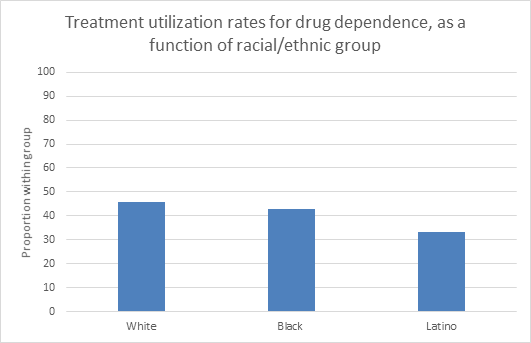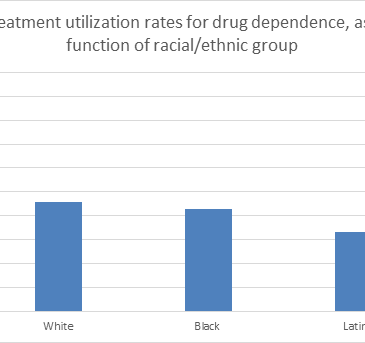In the United States, people of color are less likely to access effective treatment for psychiatric disorders, including substance use disorders, than whites (Jacobson et al., 2007). A meaningful number of inmates in state correctional facilities have a substance use disorder; therefore, it is important to discover what treatment engagement disparities might exist among incarcerated people. In this week’s STASH, as part of our Special Series on Addiction within Correctional Facilities, we review a study that explores the racial and ethnic disparities in the treatment for drug dependent inmates in U.S. state correctional facilities (Nowotny, 2015).
Methods
- The study used data from the 2004 Survey of Inmates in State Correctional Facilities (US Department of Justice, 2004).
- The sample included 5,180 inmates selected from a larger pool because they met inclusion criteria including meeting DSM-IV criteria for drug dependence disorder.
- The sample was 46% White, 36% Black, and 18% Latino. Most (71%) of the participants were men and participants were, on average, 34 years old.
- Using computerized personal interviewing, the investigators identified whether participants received treatment of any kind for their drug dependence during their current incarceration. Treatment could take the form of detox, inpatient/outpatient care, self-help groups, maintenance drugs (e.g., methadone), or any other program. The researchers also measured mental health status, other aspects of incarceration experience/offense, and external social support (e.g., receiving phone calls or visits from friends/family).
- The authors examined the likelihood that inmates participated in treatment using fixed effects logistic regressions. They explored whether whites were more likely to receive treatment for drug dependence than blacks or Latinos. They also studied whether other factors predicted treatment use.
Results
- Figure 1 shows the rate of treatment use for the three participant groups. In comparison to white counterparts, Latino inmates were less likely to receive treatment while incarcerated in state correctional facilities. Additional analyses revealed that black inmates were also more likely than Latino inmates to receive treatment.
- There were no statistical differences between black and white inmates with regard to treatment use.
- Self-help groups were the most frequently reported type of treatment. Minorities of participants reported receiving detox treatment (27%) or maintenance medication treatment (35%).
- Participants who received visits from family/friends or participated in a vocational/job training program were more likely to receive drug dependence treatment.
- White inmates in comparison to black and Latino inmates had greater social support from family and friends while incarcerated.

Figure. Click image to enlarge.
Limitations
- This study focused upon utilization of treatment, whereas previous studies have shown that there also are disparities in access to care, quality of care received, and access to continuity of care. Future research could examine potential disparities in these other important outcomes to determine how best to achieve uniform access to care.
- The study relied on participants’ retrospective reports of their symptoms of drug dependence, rather than on more standardized intake interviews. This feature of the study might have reduced the accuracy of classification.
Conclusion
The current study shows relatively low rates of drug dependence treatment among Latino inmates in U.S. State correctional facilities. Even among white and black inmates, fewer than half of inmates reported receiving necessary treatment for their substance use disorder, and even fewer reported receiving evidence-based and humane treatment options including detox and maintenance medication. Additionally, it indicates that there is a relationship between treatment use and external social support. Future research could explore how prison-based treatment plans might incorporate external social support to increase participation and improve treatment outcome. Effective treatment for substance use disorders and other psychiatric conditions might reduce subsequent relapse and criminal recidivism, in addition to improving overall quality of life. Therefore, future research should collect more detailed information about the reasons of treatment use disparities.
— Michelle Lin
What do you think? Please use the comment link below to provide feedback on this article.
References
Jacobson J.O., Robinson P.L., & Bluthenthal R.N. (2007). Racial disparities in completion rates from publically funded alcohol treatment: Economic resources explain more than demographics and addiction severity. Health Services Research, 42,773-794.
Nowotny, K. (2015). Race/ethnic disparities in the utilization of treatment for drug dependent inmates in U.S. State correctional facilities. Addictive behaviors, 40, 148-153.
United States Department of Justice (2004). Bureau of Justice Statistics. Survey of Inmates in State and Federal Correctional Facilities. ICPSR04572-v1. Ann Arbor, MI: Inter-university Consortium for Political and Social Research.




